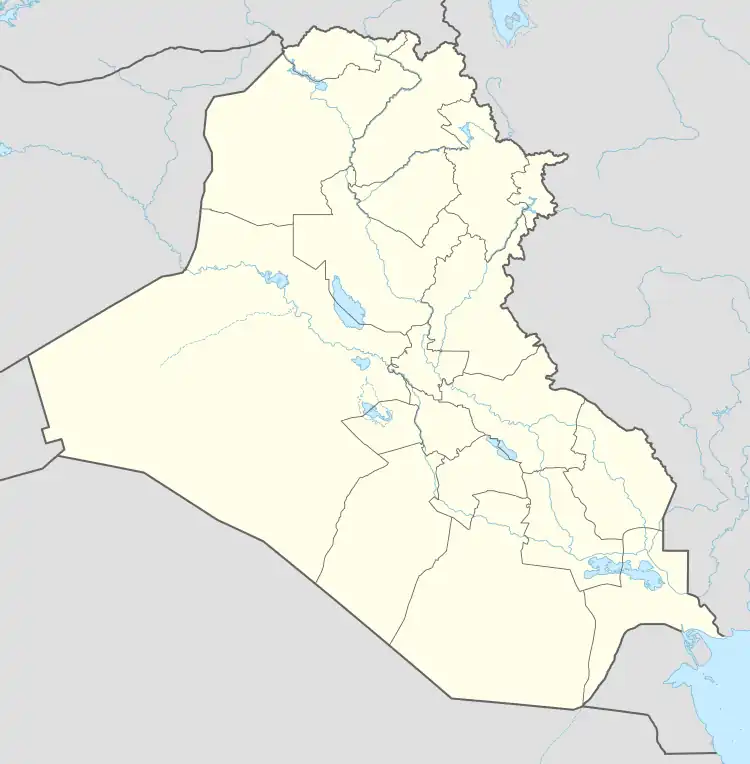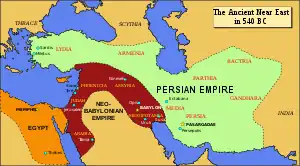 Shown within Iraq | |
| Location | Baghdad Governorate, Iraq |
|---|---|
| Region | Mesopotamia |
| Type | Settlement |
Opis (Akkadian Upî or Upija; Ancient Greek: Ὦπις) was an ancient ancient Near East city near the Tigris, not far from modern Baghdad. The equivalence of Opis and Upi are now usually assumed but not yet proven. Early on it was thought that the ideogram for Upi might refer to Kesh or Akshak.[1] Its location is not yet known with certainty though Tall al-Mujailāt has been proposed. That site has also been suggested as the location of the ancient city of Akshak.[2]
Location
Akkadian and Greek texts indicate that it was located on the east side of the Tigris, near the Diyala River.[3] The precise site of the city has been uncertain for a long time, though at one point thought to be near or under the city of Seleucia. [4] The site of Tel Abir was also proposed as the location of Opis.[5][6]
_of_Marduk-nadin-akhe%252C_1099-1082_BC.jpg.webp)
Recent geographical surveys of ancient Mesopotamia tentatively identify Opis with the mound called Tall al-Mujailāt (also Tulūl al-Mujaili` or Tulūl Mujaili` or el-Mjel'aat), 20 miles southeast of the modern city of Baghdad, 15 kilometers north of ancient Ctesiphon, and 47 miles northeast of ancient Babylon.[7][8][9] The site has an extent of 500 meters by 200 meters with a maximum height of 6.5 meters above the plain. Surface material showed occupation from the Early Dynastic through the Neo-Babylonian periods.[10]
A Kudurru dated to the 13th year of Second Dynasty of Isin ruler Marduk-nadin-ahhe (c. 1095–1078 BC) was found at Tulūl al-Mujaili`. It was recorded at "the city Opis". The land in question was part of the city of Dur-Sharrkin "Fortress of Sargon" (location unknown). Not to be confused with the much later Neo-Assyrian fortress.[11]
History
A Kudurru from the reign of Adad-apla-iddina (c. 1064–1043) excavated at Assur is dated at Opis.[12]

The Neo-Babylonians dug the "royal canal" between the Euphrates and the Tigris, which ended near Opis. The Neo-Babylonian king Nebuchadnezzar II (605–562 BC) built a long wall between the two rivers to protect against a potential Median invasion; the fortified line began at Sippar and continued eastward beyond the Tigris and ended near Opis.[13]
- Persian Conquest
In October 539 BC, the troops of the Babylonian king Nabonidus (556–539 BC) defended Opis against the Persians commanded by Cyrus the Great (559–530 BC). The Babylonians were defeated and the native population revolted against its government. Without further fighting, Cyrus captured Babylon. Opis was located near the Persian Royal Road, which connected the former Elamite capital Susa to the Assyrian heartland around Erbil and, further to the west, the Lydian capital Sardis.[14]
- Macedonian Conquest
In September 331 BC, the Macedonian king Alexander the Great (336–323 BC) defeated Darius III of Persia (336–330 BC) at the Battle of Gaugamela, and probably took possession of Opis about the same time as Babylon. A few years later, Alexander was forced by a mutiny at the Hyphasis (now Beas) River to return from the long campaign in India, and his European troops revolted again at Opis (autumn 324 BC). In an attempt to craft a lasting harmony between his Macedonian and Persian subjects, he took an oath of unity before 9,000 Persian and Greek troops at Opis.[15] In a similar vein, he had married Stateira (the daughter of Darius) and celebrated a mass marriage of his senior officers to Persian and other Eastern noblewomen at Susa just before coming to Opis.[16]
- Hellenic Rule
Seleukos I Nikator (306–281 BC), one of Alexander's Diadochi (Successors), founded the Seleucid Empire and built his Mesopotamian capital Seleukeia west of the river Tigris, some 12 miles (19 km) southwest of Opis. The Hellenistic city of Seleukeia rapidly eclipsed older Mesopotamian centers in the region like Babylon, Sippar, and Opis.
In the 2nd century BC, the Parthian Empire conquered the eastern provinces of the Seleucid Empire, including Seleukeia and Opis. Both cities were, in their turn, largely eclipsed by the emergence of the new Parthian (and subsequently Persian) capital Ktesiphon nearby, in-between Seleukeia and Opis.
See also
References
- ↑ Ungnad, Arthur, "Zur Lage von Upî-Opis", Zeitschrift Der Deutschen Morgenländischen Gesellschaft, vol. 67, no. 1, pp. 133–35, 1913
- ↑ Gentili, Paolo, "Opis E Le Altre", Studi Classici e Orientali, vol. 51, pp. 25–53, 2005
- ↑ Clark Hopkins, "A Bird's-eye View of Opis and Seleucia", Antiquity, vol. 13, iss. 52, pp. 440-448, December 1939
- ↑ R. H., "Excavations in Iraq", The Bulletin of the Cleveland Museum of Art, vol. 17, no. 7, pp. 133-135, Jul 1930
- ↑ William Horsburgh Lane, "Babylonian Problems", J. Murray, 1923
- ↑ Luckenbill, D. D., "The Site of Opis", The American Journal of Semitic Languages and Literatures, vol. 40, no. 2, pp. 148–51, 1924
- ↑ S. Parpola and M. Porter, "The Helsinki Atlas of the Near East in the Neo-Assyrian Period", Helsinki, 2001 ISBN 9789514590504
- ↑ P. Högelmann and K. Buschmann, "Östlicher Mittelmeerraum. Das achämenidische Westreich von Kyros bis Xerxes (547–479/8 v. Chr.)", in Tübinger Atlas des Vorderen Orients, B IV 23, 1986
- ↑ R. J. Talbert, "Barrington Atlas of the Greek and Roman World", Princeton 2000 ISBN 9780691049458
- ↑ Adams, Robert M., "Land Behind Baghdad: A History of Settlement on the Diyala Plains", Chicago and London: University of Chicago Press, 1965
- ↑ K. al-Admi, "Kudurru of Maroduk-nadin-ahhe, IM 90585", Sumer 38, Sumer 38, pp. 121-133, 1982
- ↑ Frame, Grant, "A Kudurru Fragment from the Reign of Adad-apla-iddina", Altorientalische Forschungen", vol. 13, no. 1-2, pp. 206-211, 1986
- ↑ R. D. Barnett, "Xenophon and the wall of Media", JHS 83, 1963
- ↑ A. T. Olmstead, "History of the Persian Empire", Chicago, 1948
- ↑ Roisman, Joseph, "Alexander and Discontent: The King and His Army in India and Opis, Mesopotamia", Alexander’s Veterans and the Early Wars of the Successors, New York, USA: University of Texas Press, pp. 31-60, 2012
- ↑ Nagle, D. Brendan, "The Cultural Context of Alexander's Speech at Opis", Transactions of the American Philological Association, vol. 126, pp. 151-172, 1996
Further reading
- Lendle, Otto, "Xenophon In Babylonien: Die Märsche Der Kyreer von Pylai Bis Opis", Rheinisches Museum Für Philologie, vol. 129, no. 3/4, pp. 193–222, 1986
- Ross, J., "A Journey from Baghdad to the Ruins of Opis and the Median Wall", in Journal of the Royal Geographical Society, vol. 11, pp. 121–136, 1841
- Saporetti, Claudio, "Opis E Il Muro Della Media", Egitto e Vicino Oriente, vol. 27, pp. 95–102, 2004
- Fritz Wüst, "Die Meuterei von Opis (Arrian VII, 8; 11, 1-7)", Historia: Zeitschrift Für Alte Geschichte, vol. 2, no. 4, pp. 418–31, 1954
- Fritz R. Wüst, "Die Rede Alexanders Des Grossen in Opis, Arrian VII 9-10", Historia: Zeitschrift Für Alte Geschichte, vol. 2, no. 2, pp. 177–88, 1953